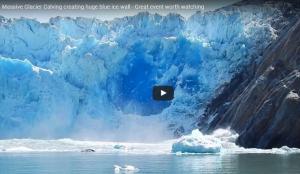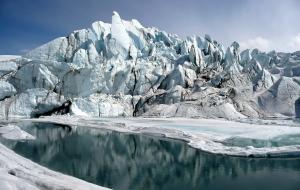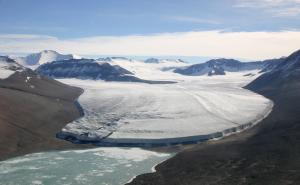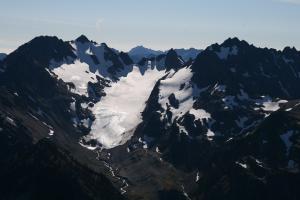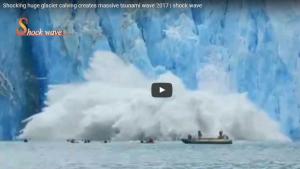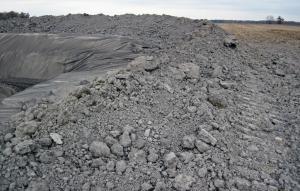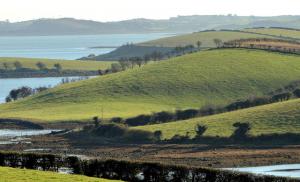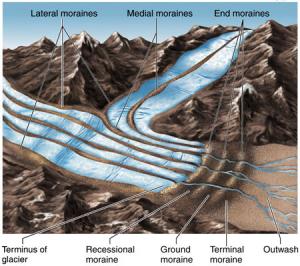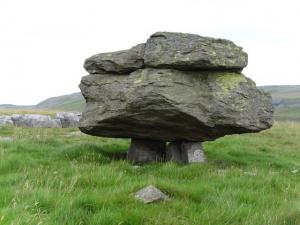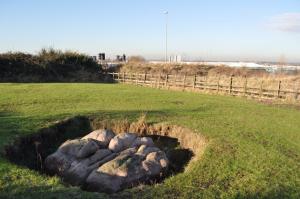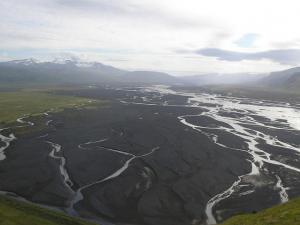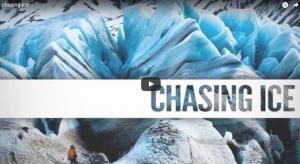Erosion by Glaciers
Section 1
Daily Dose of Destruction
Glaciers are large masses of moving ice and snow. Don't confuse them with icebergs. Icebergs were once part of glaciers, but have broken off and are floating on a body of water. Glaciers are formed when snow doesn't melt all the way and begins to pile up. The heavy snow layers on the top compress and compact the snow below. If you have ever been in a snowball fight you probably have experimented with this process. You take some snow in your hand, squeeze and compress it, the snow heats a little and the interlocking crystals move closer together forming ice or harder snow. The same happens to the layers below the top when there is enough friction that it slightly melts the lower layers making those ice crystals move closer together and harden as the water refreezes into ice. The bottom of a glacier becomes a little pliable, sort of like silly putty. This allows it to move downhill due to the force of gravity.
|
|
|
There are two types of glaciers, continental and alpine. Continental glaciers are huge masses of ice and cover large areas of land. During the ice ages, the Earth might have been 28% covered with glaciers. There have been many ice ages, but the last one occurred about 2 or 3 million years ago. Glaciers still cover about 10% of the Earth. These glaciers were so large that they covered mountains and carved out some fantastic valleys that we have turned into national parks like Yosemite. Continental glaciers can be so large that they weigh enough to push some of the crust into the mantle. After the glacier melts the land goes through what is known as a post-glacial rebound, where the land begins to rise up out of the mantle. There is a village called Alby, in Sweden, and due to this post-glacial rebound, it is no longer the fishing village it used to be. As Alby began to rise the sea began to move away from the village.
Alpine glaciers are smaller glaciers that carved out some of these mountains and valleys. There are just a few alpine glaciers left. There are some beautiful landmarks, landforms, and landscapes that have been sculpted by these alpine glaciers.
|
|
|
As glaciers move down the slope, sometimes they will "pluck" up rocks from below and begin to drag those rocks. The dragging rocks scratch deep grooves into the rock below. The scratches are called glacial grooves.
|
|
|
Below is a slideshow that demonstrates some of the awesome, majestic landscapes that have been formed by glaciers.
In the following lab, you will become a scientist and discover how glaciers grow, shrink, and move as well as calculate the rate of speed that your created glacier is moving over time.
If you are a student at Snowflake, Holbrook or Heber click here to access the SUSD5 student version of the Phet Glacier Lab.
Purchase a copy of the Phet Glacier Lab at Teacher Pay Teachers for $1.00.
Section 2
Daily Dose of Destruction
We have already mentioned that glaciers and ice weather rock and then move that rock to another location. When the glacier runs out of energy or melts it deposits its load. This next section will deal with glacial deposition. The mixture of different sized sediments that were moved by the glacier is called till. If you ever come across a hill that is made out of till you would call that a drumlin. If you lay a spoon upside down on a table and look at the spoon part, not the handle, you are looking at the shape of a drumlin. Where you find one drumlin, you probably will find more as they are often found in what is known as a drumlin field. The direction the drumlin is pointing is in the direction the glacier was moving at the time of its formation.
|
|
|
Moraines are glacier deposits that form at the edges of the glacier. The moraines found at the farthest point the glacier has ever reached are called terminal moraines. A moraine that is pinched between two glaciers is called the medial moraine, similar to the word median which is the middle barrier between parts of highways. Lateral moraines are the moraines that are found at the outer edges of glaciers.
If you are walking in the wilderness and come across a rock or rocks that clearly do not belong in the area, then you might be looking at an erratic. Erratics are carried long distances on top or inside of a glacier. When the glacier melts it deposits this erratic. It literally is a rock that just does not fit into its surroundings. Erratics can be dropped into the middle of the ocean by icebergs and then when the ocean sediment turns to rock it will include this erratic. So if you are ever looking at limestone and then notice a big chunk of sandstone in the middle of it, you might be looking at an erratic.
|
|
An outwash plain is the glacial till that is deposited by the glacier's melted runoff. You will find outwash plains at the base of glaciers, usually accompanied by rivers and near ocean shores.
The next video, "Chasing Ice," explores a bit of climate change and shows a photographer that has gone out over the years taking thousands of pictures of glaciers, glacier calving, and glacier receding. Although this video is politically motivated, you can take it for what it is worth. The purpose of the video is to see all the different landforms, landscapes, and deposits that glaciers make, as well as watch a great photographer get some of the greatest images and video footage of glaciers. If you watch it for that reason, you will like the video.










